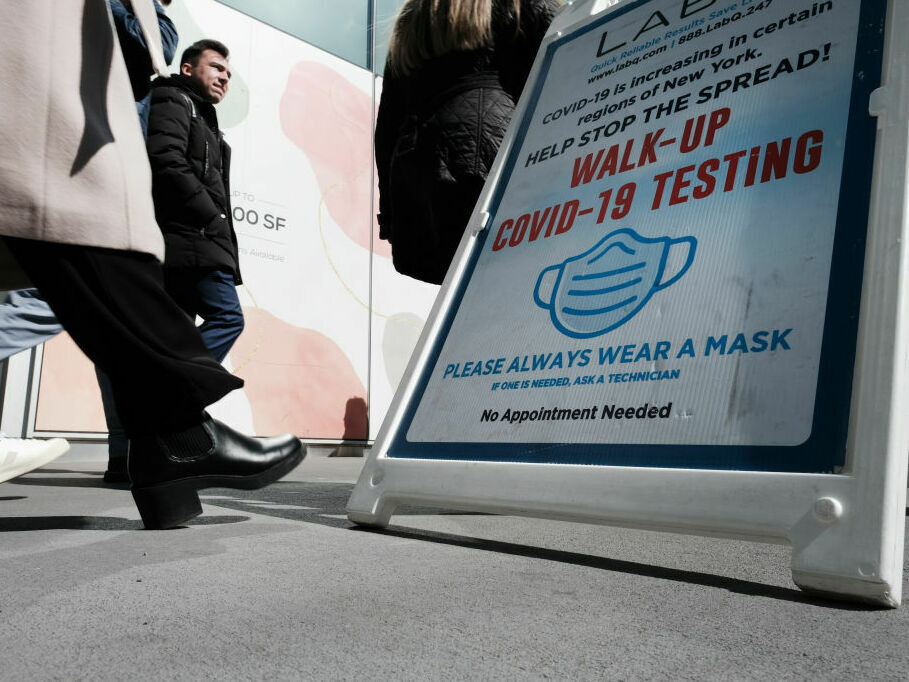[ad_1]

The CDC will halt reporting new daily COVID bacterial infections and rely in its place on hospitalization information to observe the severity of the COVID.
Spencer Platt/Getty Images
disguise caption
toggle caption
Spencer Platt/Getty Pictures

The CDC will quit reporting new day by day COVID infections and depend instead on hospitalization details to keep an eye on the severity of the COVID.
Spencer Platt/Getty Visuals
In the hottest sign that the pandemic is receding, the Centers for Condition Command and Prevention Friday announced strategies to scale back the info the agency will routinely report about COVID-19.
But CDC officers pressure that the information and facts the agency will still carry on to obtain and routinely article on its internet site will nonetheless provide the needed metrics to monitor the coronavirus and discover and answer to any new threats.
“We will carry on to hold our eye on the COVID-19 ball,” Dr. Nirav Shah, the CDC’s principle deputy, instructed reporters in saying the change. “And will do so by a multitude of metrics.”
The variations are prompted by the coming close of the General public Health and fitness Emergency which is established to expire on May 11.
One of the most important improve is that the agency will no lengthier often monitor and release the variety of new COVID bacterial infections. That is largely for the reason that states will no more time be required to report new cases. In addition, property screening, which primarily is just not claimed to authorities, has manufactured new bacterial infections a significantly less dependable metric, Shah suggests.
As an alternative, the company will start relying on the selection of men and women staying hospitalized for COVID as an indicator of how a great deal the virus is spreading. A CDC assessment of the new method launched Friday confirmed it will be powerful, Shah suggests.
The CDC will also go on to monitor and report how many individuals are dying from COVID as perfectly as how typically men and women are finding so unwell they conclude up demanding treatment in unexpected emergency rooms.
Wastewater checking for the virus, as properly as the proportion of men and women tests good for the virus — “check positivity” — will supply more vital metrics, he claims.
In addition, the agency will continue to monitor genetic analyses of the virus, which includes among arriving intercontinental vacationers, to spot any new, perhaps worrisome variants.
The modifications didn’t surprise unbiased general public health specialists.
“Over-all some excellent news in this article,” wrote Sam Scarpino, an infectious illness researcher at Northeastern University in an email to NPR. “Continuing wastewater, traveler screening, and genome sequencing will be critical to ensure the infrastructure is maintained for the next time we require it.”
But others voiced concern that investments in general public wellness ended up currently being rolled again.
“This comes as no surprise at all but is even further evidence that these investments had been always temporary and not component of a long term approach to be far better public health information stewards,” states Beth Blauer, who assisted operate a very highly regarded COVID information tracker at Johns Hopkins that ceased procedure ceased procedure in March.
Some others are anxious that the improvements will outcome in patchwork surveillance actions.
“Wastewater surveillance is … definitely spotty, so there’d be huge parts of the nation not covered by this surveillance,” wrote Jennifer Nuzzo, who heads Brown University’s Pandemic Centre, in an email.
“I am most concerned about how we keep track of hospitalizations,” she says. “At this issue in the pandemic, hospitalizations are the best indicator of no matter if the degree of bacterial infections that are transpiring will be disruptive. But we are scaling back again the level of medical center data we are collecting.”
Nuzzo also argues that “we really should be applying this time period of relative quiet to fortify our surveillance of really serious respiratory bacterial infections that land folks in the hospital.”
Which is crucial for the reason that “we are even now trying to sort out who is hospitalized with or for COVID and minimizing the frequency with which facts are documented can make it harder to parse the information and interpret their indicating. It also would make it more challenging to act swiftly.”
Scarpino agrees there could be issues.
“Relocating from state to regional stage facts and the elimination of county-degree possibility will guide to even extra disengagement from the public and media,” he wrote in an e mail.
“Even with the gains we’ve created, deaths are however way too high,” Scarpino notes. They’re at present hovering all around 1,100 a week, according to CDC facts. There have been 1.1 million COVID deaths in overall in the U.S. to date.
“The CDC really should be redirecting attempts to comprehending in as true-time as doable what’s driving variability throughout states and areas in mortality,” he claims.
The move to scale back some of its facts endeavours, he claims, “indicators that the CDC has presented up on lessening mortality, which is unacceptable.”
Editing by Carmel Wroth.
[ad_2]
Supply hyperlink

